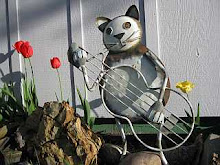Today I finished the work to replace the loading corral's side gate. I planned to replace this wooden gate for a few years now but I would get sidetracked and then forget. The wooden gate worked, but over the years one post started to lean a little so the sliding catch would be hard to slide into the post to close/lock the gate. And the gate's hinges were getting loose and the gate was starting to sag on one end. I thought this gate was what I had bought when I got the wooden panels at an auction. But when I read my original blog post when I installed this gate, it said I had made the gate. And another reason to replace this gate, the cattle now have figured out how to slide the catch and then they open the gate.
I had rebuilt this part of the loading corral back in 2008. Here are a couple posts about it.
https://tallpinesranch.blogspot.com/2008/12/before-snow-flies-and-ground-freezes.html
https://tallpinesranch.blogspot.com/2009/01/loading-corral-gate.html
I had planned to replace the gate on Sunday but Donna's friend, Mabel, needed her house roof fixed. A fallen tree branch earlier had put a hole in the metal roofing. While on the roof I also saw the rain gutters were plumb full of pine needles. The gutters hadn't been cleaned in years. So I cleaned all the gutters. In the end I ran a garden hose in the gutters and used water to make sure the downspouts were also cleared. This took me much of the afternoon.
When I got home I started on the gate replacement. I took the old gate off, moved one of the lag bolts to a different spot, then installed a metal gate. The metal gate is a foot longer than the old gate, so I needed to move the railroad tie that is a fence post. Before doing that, three other railroad ties were leaning a little. That is due to the cattle pushing against them over the years. I dug around the three railroad ties so I could move them to be straight.
Why the one railroad tie leaned was because the cattle liked to scratch against the small board I had nailed to the post. The small board's purpose was to hold the long metal corral gate when the gate was open. Later I had a small short piece of a railroad tie and I placed that in the ground to set the open gate on. I never took the board off the railroad tie.
I also used the tractor to move a couple railroad ties and two long wooden beams/posts.
It was getting dark by now on Sunday, so today, Monday, I finished the work. Yesterday one of the pins for the tractor's forks didn't want to completely fit, so today I did a little drilling so the pin would completely fit.
In the daylight I could make sure the leaning railroad ties were now straight, and I filled the dirt in around them.
Then it was time to move the one railroad tie post. I needed to move the post over one foot. The wooden gate was 5 ft wide. Most metal gates are 4 or 6 feet wide. The post is 30 inches into the ground. I dug a new hole next to the post. This part of the ranch is mostly gravel and rocks below ground. That made digging harder and longer.
When I rebuilt the loading corral in 2008 I was 15 years younger. Back then, it was tough, but I was able to stand up these long railroad ties and drop them into the hole. I didn't have a tractor back them to help me. Now... I don't think I can lift the railroad ties out of the hole, and don't want to try. And I have a tractor now. So I used the tractor to lift and move the railroad tie. At one point the railroad tie slipped from the chain and fell on top of the fence panel. The tie didn't break the fence panel, but did knock off the board above the panel.
The beginning and the end. I had liked the look of the wooden gate, but it was slow and hard to use. When loading cattle I may need to quickly open this gate.


















No comments:
Post a Comment